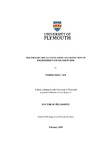The Dietary Bioaccumulation and Detection of Engineered Nanosilver in Fish
| dc.contributor.supervisor | Handy, Richard | |
| dc.contributor.author | Clark, Nathaniel | |
| dc.contributor.other | School of Biological and Marine Sciences | en_US |
| dc.date.accessioned | 2019-07-24T14:18:59Z | |
| dc.date.issued | 2019 | |
| dc.date.issued | 2019 | |
| dc.identifier | 10261715 | en_US |
| dc.identifier.uri | http://hdl.handle.net/10026.1/14696 | |
| dc.description | Published in part as: Clark, N. J., Boyle, D. and Handy, R. D. (2019). An assessment of the Dietary Bioavailability of Silver Nanomaterials in Rainbow Trout Using an Ex Vivo Gut Sac Technique. Environmental Science: Nano. 6, 646-660. DOI: https://doi.org/10.1039/C8EN00981C Clark, N. J., Boyle, D., Eynon, B. P. and Handy, R. D. (2019). Dietary exposure to silver nitrate compared to two forms of silver nanoparticles in rainbow trout: bioaccumulation potential with minimal physiological effects. Environmental Science: Nano. 6, 1393-1405. DOI: https://doi.org/10.1039/C9EN00261H | en_US |
| dc.description | Embargo extended to 24.07.21. Approved by DC. LW 01.06.20 | |
| dc.description.abstract |
Emerging contaminants, including engineered nanomaterials (ENMs), need to undergo environmental risk assessment, whereby they are tested for properties of persistence in the environment, toxicity or bioaccumulation. To date, little data exists for the bioaccumulation of ENMs in animals, particularly fish, with a focus on alternative methods to in vivo testing. Also, interpretation of data for hazard assessment is hampered by the lack of routine methods to detect the form of materials in the tissues following exposure. Therefore, there were three main aims to the thesis; the first was to determine the dietary accumulation of ENMs into fish, using a tiered testing approach. The first step was using a short term (4 h) gut sac technique to demonstrate the bioavailability of Ag materials, using pristine (Ag NPs) and aged (Ag2S NPs) materials. The order of total Ag accumulation was AgNO3 > Ag NPs = Ag2S NPs; in the mid intestine muscularis, there was 457 ± 111, 38 ± 8 and 39 ± 20 ng/g, respectively. The next step in the testing strategy was an in vivo exposure, whereby fish were fed diet containing 100 mg Ag/kg for 4 weeks. Following this, the liver was the main organ of accumulation for all materials, with 4 weeks of exposure leading to concentrations of 122 ± 10, 129 ± 17 and 11 ± 1 µg/g in the AgNO3, Ag NPs and Ag2S NPs, respectively. The order of bioaccumulation was AgNO3 = Ag NPs > Ag2S NPs. Various gut transformations (e.g. dissolution) may have been responsible for the similarity of the AgNO3 and Ag NP treatments, and differences between order in the short term gut sac experiment. The second aim was to develop a method of determining the form of the material in the tissues (particulate versus dissolved). A method was developed using the pristine Ag NPs, whereby a series of potential extractants were used. The only suitable extraction method was tetramethylammonium hydroxide + 5 mM CaCl2, and was verified by extracting Ag as AgNO3 and Ag NPs from gut sac tissues without any change to the form of Ag. When this method was applied to in vivo samples (as above), it showed 83 ± 20, 73 ± 17 and 5 ± 2 x109 particles/g dw in the liver of AgNO3, Ag NPs and Ag2S NP, respectively. Particles were also found in the hind intestine and kidney. The presence of particles in the AgNO3 treatment support the idea that nano-sized particles can be synthesised in the gut lumen or gut tissue, and subsequently transported around the body to the liver. The third aim of this work was to compare rodent gut accumulation with fish, in an exploratory attempt to determine whether rodent bioaccumulation testing can be replaced by fish. This utilised the gut sac technique (as above for fish) in Wistar rats. The total Ag tissue concentrations were higher in the rat (2514 ± 267, 907 ± 284, 1482 ± 668 ng/g in the AgNO3, Ag NPs and Ag2S NPs, respectively), but showed the same accumulation profile of AgNO3 > Ag NPs > Ag2S NPs as in fish. One species difference was transepithelial accumulation was shown in the rat, but not in fish. In conclusion, the ex vivo gut sac technique with adequate characterisation information, could predict the pattern of in vivo bioaccumulation of the Ag materials used here. Particles were present in the hind intestine, liver and kidney of all Ag treatments following dietary exposure, and to a lesser extent in the Ag2S NP treatment, indicating ENM chemistry has an important role in bioavailability. Finally, the rat gut sac experiment did not produce the same data as the fish gut sac experiment, but shows the current risk assessment of dissolved Ag will cover Ag ENMs. | en_US |
| dc.language.iso | en | |
| dc.publisher | University of Plymouth | |
| dc.rights | Attribution-NonCommercial-NoDerivs 3.0 United States | * |
| dc.rights.uri | http://creativecommons.org/licenses/by-nc-nd/3.0/us/ | * |
| dc.subject | Nanomaterials | en_US |
| dc.subject | Gut accumulation | en_US |
| dc.subject | Dietary exposure | en_US |
| dc.subject | Fish | en_US |
| dc.subject | Rainbow trout | en_US |
| dc.subject | Wistar rats | en_US |
| dc.subject | Method development | en_US |
| dc.subject | Single particle ICP-MS | en_US |
| dc.subject.classification | PhD | en_US |
| dc.title | The Dietary Bioaccumulation and Detection of Engineered Nanosilver in Fish | en_US |
| dc.type | Thesis | |
| plymouth.version | publishable | en_US |
| dc.identifier.doi | http://dx.doi.org/10.24382/441 | |
| dc.rights.embargodate | 2020-07-24T14:18:59Z | |
| dc.rights.embargoperiod | 12 months | en_US |
| dc.type.qualification | Doctorate | en_US |
| rioxxterms.version | NA | |
| plymouth.orcid.id | 0000-0002-0968-503X | en_US |
Files in this item
This item appears in the following Collection(s)
-
01 Research Theses Main Collection
Research Theses Main



